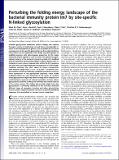Perturbing the folding energy landscape of the bacterial immunity protein Im7 by site-specific N-linked glycosylation
Author(s)
Chen, Mark; Bartlett, Alice I.; Nerenberg, Paul S.; Friel, Claire T.; Hackenberger, Christian P. R.; Radford, Sheena E.; Imperiali, Barbara; Stultz, Collin M; ... Show more Show less
DownloadChen-2010-Perturbing the folding emergy landscape.pdf (790.7Kb)
PUBLISHER_POLICY
Publisher Policy
Article is made available in accordance with the publisher's policy and may be subject to US copyright law. Please refer to the publisher's site for terms of use.
Terms of use
Metadata
Show full item recordAbstract
N-linked glycosylation modulates protein folding and stability through a variety of mechanisms. As such there is considerable interest in the development of general rules to predict the structural consequences of site-specific glycosylation and to understand how these effects can be exploited in the design and development of modified proteins with advantageous properties. In this study, expressed protein ligation is used to create site-specifically glycosylated variants of the bacterial immunity protein Im7 modified with the chitobiose disaccharide (GlcNAc-GlcNAc). Glycans were introduced at seven solvent exposed sites within the Im7 sequence and the kinetic and thermodynamic consequences of N-linked glycosylation analyzed. The ΔΔG° [delta delta G superscript 0 or degree symbol] values for glycan incorporation were found to range from +5.2 to -3.8 kJ·mol-1. In several cases, glycosylation influences folding by modulating the local conformational preferences of the glycosylated sequence. These locally mediated effects are most prominent in the center of α-helices where glycosylation negatively effects folding and in compact turn motifs between segments of ordered secondary structure where glycosylation promotes folding and enhances the overall stability of the native protein. The studies also provide insight into why glycosylation is commonly identified at the transition between different types of secondary structure and when glycosylation may be used to elaborate protein structure to protect disordered sequences from proteolysis or immune system recognition.
Date issued
2010-12Department
Harvard University--MIT Division of Health Sciences and Technology; Massachusetts Institute of Technology. Department of Biology; Massachusetts Institute of Technology. Department of Chemistry; Massachusetts Institute of Technology. Department of Electrical Engineering and Computer Science; Massachusetts Institute of Technology. Department of PhysicsJournal
Proceedings of the National Academy of Sciences of the United States of America
Publisher
National Academy of Sciences
Citation
Chen, M. M. et al. “Perturbing the Folding Energy Landscape of the Bacterial Immunity Protein Im7 by Site-specific N-linked Glycosylation.” Proceedings of the National Academy of Sciences 107.52 (2010) : 22528-22533.
Version: Final published version
ISSN
0027-8424
1091-6490